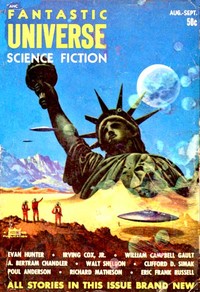The House from Nowhere by Arthur G. Stangland
"The House from Nowhere" by Arthur G. Stangland is a science fiction novel written in the early 1950s. The story explores themes of societal evolution, the impact of technology on morality, and the differences between modern conveniences and traditional values. Set in a future where human interactions have grown increasingly mechanical and superficial, the book presents a contrast between the protagonist's life and that of his new neighbors, the MacDonalds, who embody
a more genuine and old-fashioned way of living. The narrative follows Philon Miller, a man caught in a web of political and personal struggles. As he grapples with the pressures of a political quota system that demands him to raise a significant amount of money for his party, he becomes increasingly fascinated and disturbed by the MacDonald family, who have recently moved into the neighborhood with their archaic practices, including cooking meals traditionally in their home. Philon's son, John, becomes engaged with the MacDonald children, prompting Philon to question his own values. As tensions rise and Philon's desperation leads him to unethical choices, the story culminates in a tragic turn of events that forces him to confront the cost of his ambitions and the emptiness of his lifestyle, leading to John’s departure in search of a more authentic connection to life. (This is an automatically generated summary.)
Read or download for free
| How to read | Url | Size | |||
|---|---|---|---|---|---|
| Read now! | https://www.gutenberg.org/ebooks/31588.html.images | 63 kB | |||
| EPUB3 (E-readers incl. Send-to-Kindle) | https://www.gutenberg.org/ebooks/31588.epub3.images | 78 kB | |||
| EPUB (older E-readers) | https://www.gutenberg.org/ebooks/31588.epub.images | 76 kB | |||
| Kindle | https://www.gutenberg.org/ebooks/31588.kf8.images | 116 kB | |||
| older Kindles | https://www.gutenberg.org/ebooks/31588.kindle.images | 109 kB | |||
| Plain Text UTF-8 | https://www.gutenberg.org/ebooks/31588.txt.utf-8 | 56 kB | |||
| Download HTML (zip) | https://www.gutenberg.org/cache/epub/31588/pg31588-h.zip | 76 kB | |||
| There may be more files related to this item. | |||||
Similar Books
About this eBook
| Author | Stangland, Arthur G., 1908-1990 |
|---|---|
| Title | The House from Nowhere |
| Series Title | Produced from Fantastic Universe Aug-Sept 1953. |
| Credits |
Produced by Sankar Viswanathan, Greg Weeks, and the Online Distributed Proofreading Team at http://www.pgdp.net |
| Reading Level | Reading ease score: 76.6 (7th grade). Fairly easy to read. |
| Language | English |
| LoC Class | PS: Language and Literatures: American and Canadian literature |
| Subject | Science fiction |
| Subject | Short stories |
| Subject | Time travel -- Fiction |
| Category | Text |
| EBook-No. | 31588 |
| Release Date | Mar 10, 2010 |
| Copyright Status | Public domain in the USA. |
| Downloads | 150 downloads in the last 30 days. |
| Project Gutenberg eBooks are always free! | |

